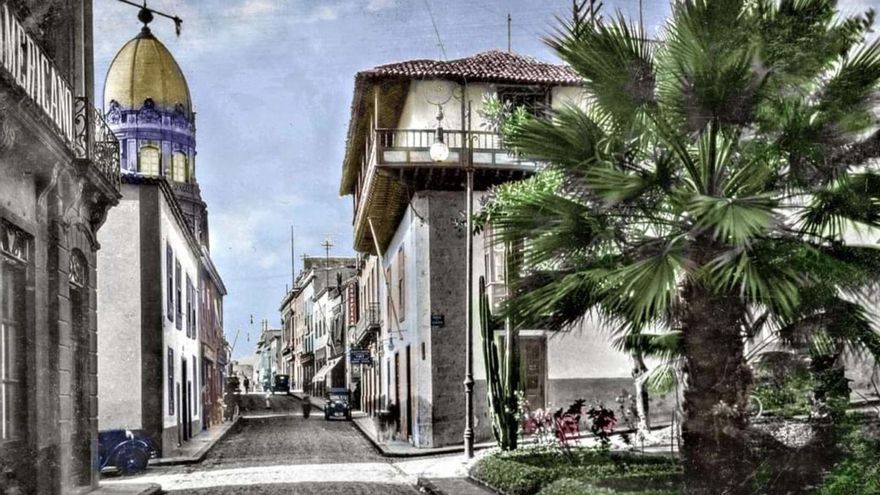
Isabel Arundell, an English aristocrat, recounts her honeymoon in Santa Cruz de Tenerife in 1863 with the adventurer Richard Burton (*). She chose a rather unfortunate time as the island was in the grip of a yellow fever epidemic that claimed many lives.
“My husband and I arrived at the port of Santa Cruz de Tenerife in March 1863 to finally enjoy the honeymoon we had postponed due to his political commitments, as we had married on January 22, 1861. When we saw Santa Cruz from the deck of the Senegal, the steamer on which we had traveled from London, everything appeared lush with a backdrop of blue sky and its wind-exposed mountains forming irregular masses of rocks, wild and imaginative. In the background of the city, there was a small cloud shaped like a sugarloaf, on which stood the peak of Tenerife.”
“The city is very close to the sea, flat and bathed in a white color. The cliffs loom threateningly from the shore. The only tall buildings were its two churches. When the small rowing boat that had picked us up from the steamer reached the small pier, a dozen lads grabbed our luggage and gave us a little tour until we reached the Hotel Camacho, on Calle Dr. Comenge, 11 (today’s San Francisco), a comical, old, and ramshackle place, but with an intriguing interior, a reminder of grandeur and Moorish-Spanish style, better suited for drawing than for sleeping and eating.”
“The hotel had a large inner courtyard, from which a wide oak staircase led to the rooms on the upper floor, concentrated around a lovely balcony of noble wood from which hung enormous green vines that covered everything, giving it a cool and anciently romantic look. Our meals were served by Rita, a pleasant woman, neither young nor pretty, dressed in a white mantilla, with a black felt bowler hat. The food was as old as the hotel, and so were the servants.”
“Richard wanted to spend a few days in Santa Cruz, where he had already been in 1861, when he was about to take over the consulate of Fernando Poo. During this period, he noticed that the city had seen a considerable increase in buildings, especially in the street La Marina, where the offices related to the duty-free port were located.”
“But this time we had arrived at a bad time, as the city of Santa Cruz had just suffered a yellow fever epidemic in which, out of 7,240 inhabitants, 497 died. On our visit to an acquaintance of Richard’s, we found ourselves at his funeral in the street; upon asking the reason, we were told that he had contracted the fever at nine in the morning and passed away two hours later.”
“The panic in the city was so intense that when a person began to feel unwell, a coffin was brought in and the victim was placed in it upon entering a coma. Only a small amount of earth was placed over them when buried, just in case they regained consciousness. There was a case where a woman returned home dressed in her shroud, and her daughter, who was sitting at the kitchen table still mourning the death of her mother, fainted upon seeing her. Interestingly, the mother lived many more years, and even had more children; however, the daughter never recovered from the trauma and lost her mind.”
“Faced with this situation, I suggested to Richard that we should find a safer place to stay during the month we planned to spend in Tenerife, so we took a carriage and moved to La Laguna, a beautiful village located fifteen hundred feet, well above where the fever was. To leave the city, we used a good and winding road that ran through a mountain, leaving to the left a row of windmills, awaiting the arrival of Don Quixote. To enable me to see all the beauties of this island, we rented some horses and set out to explore it, even ascending to the Teide Peak.”
(*) Richard Burton (Torquay, United Kingdom, 1821-Trieste, Italy, 1890) studied at Trinity College, Oxford and, in his mature years, came to speak 25 languages and 40 dialects. Although Burton was best known for discovering the sources of the Nile, his life was marked by constant adventures, as he was the first Westerner to set foot in Mecca, disguised as an Afghan Muslim, and entered the Islamic city of Harar, where it was believed that if a European set foot in it, it would signal the end of their culture. On an expedition to Somali lands, a spear pierced his jaw, leaving him with a scar on his face that would accompany him for the rest of his life.”
Isabel Arundell (London, England, 1861 – 1896) was born into a rich and respected Catholic aristocratic family, so the marriage of a lady from British high society to a dubious reputation adventurer caused great confusion in her family. After the death of her spouse (1890), steeped in deep sadness and loneliness, she secluded herself in her consular residence in Trieste to sort through the manuscripts of her beloved Richard, burning the majority of them. They are both buried in a mausoleum, in the form of a Bedouin tent, located in the courtyard of the Church of Santa María Magdalena, in Mortlake, London”















